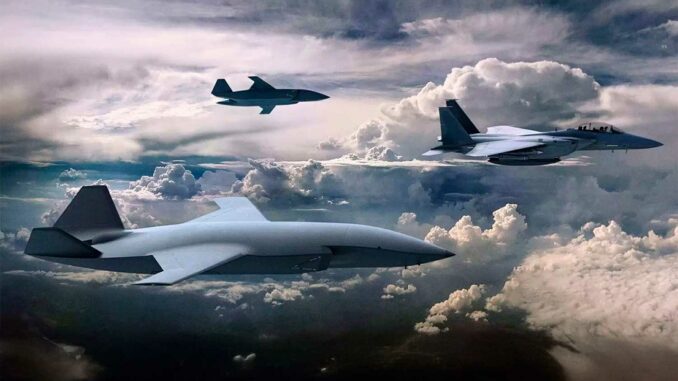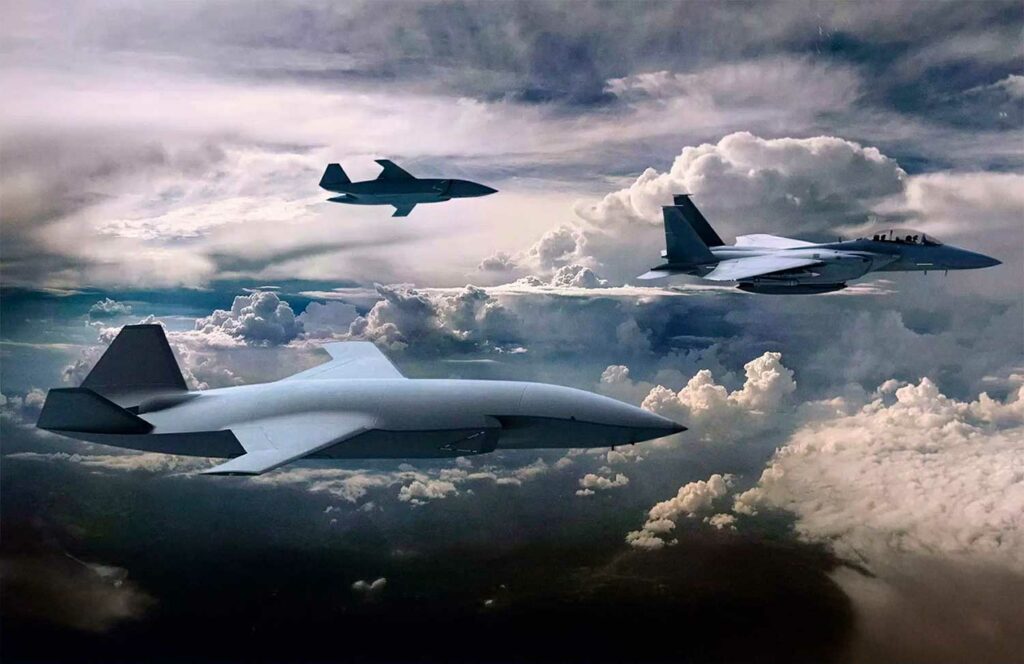
Integrating swarms of drones with fighter jets poses complex technical challenges related to communication, coordination, and cybersecurity.
The challenges of integrating swarms of drones with fighter jets
The use of drone swarms alongside manned fighter jets is a growing priority for major military powers, particularly in the United States, China, Russia, and Europe. The concept is based on combining autonomous or semi-autonomous drones capable of operating in a structured group around a lead aircraft, often a fifth-generation fighter jet. These swarms are intended to enhance air superiority by delegating certain functions such as electronic warfare, reconnaissance, and opening strikes. Boeing’s Loyal Wingman project in Australia, the US Air Force’s Skyborg program, and the efforts of the Franco-German SCAF illustrate this strategic direction.
However, the operational integration of these systems is far from guaranteed. On a technical level, several major challenges must be overcome to enable effective coordination between a human pilot and a fleet of drones, including secure communications management, real-time task allocation, jamming resistance, in-flight data processing, and sensor fusion.
The challenge is twofold: to preserve the cognitive load of the human pilot while maximizing the autonomy of the drones without taking excessive risks. This requires significant advances in mission architectures, embedded artificial intelligence, and the very design of the drones used. This article analyzes these technical barriers in depth, organizing them into three main categories: communications, tactical coordination, and cybersecurity.
The challenge of high-speed data communication and processing
One of the main technical challenges concerns the link between the fighter jet and the drones. The real-time transmission of commands, mission data, and information from sensors requires high bandwidth, minimal latency, and resilience to electronic warfare environments. The use of UHF radio waves or SATCOM is limited by physical constraints, particularly when the swarm exceeds ten units or operates at low altitude.
Current military communication standards, such as Link 16 or MADL (Multifunction Advanced Data Link), were designed for exchanges between piloted aircraft. They are not suitable for swarms of drones operating dynamically in hostile conditions without direct line of sight. Distributed protocols must therefore be developed that are capable of handling interruptions, interference and even temporary signal loss. The system must also prevent network saturation by filtering and prioritizing data.
Another problem is local information processing. To limit exchanges, drones must be able to make decisions locally. This requires the integration of powerful on-board processors capable of image analysis, object detection, and real-time mapping. In 2024, Australian Loyal Wingman prototypes were already carrying payloads of over 200 kg dedicated to autonomous analysis, but this raises questions about power consumption, cooling, and miniaturization.
The challenge is therefore twofold: ensuring reliable connections in a contested environment and developing a robust embedded computing architecture capable of processing growing volumes of data locally without constantly relying on the lead fighter.

Tactical coordination between local autonomy and centralized authority
A swarm of drones does not function as a simple extension of the fighter. The challenge is not to remotely control ten drones, but to assign them an overall objective (mission, area of action, rules of engagement) while allowing them tactical autonomy. This principle is similar to the concept of “mission command”: giving an objective without dictating every maneuver.
This approach raises many multi-agent coordination issues. How can collisions between drones or with fighter jets be avoided? How can roles (reconnaissance, decoy, strike) be dynamically assigned according to losses or unforeseen events? How can two drones be prevented from engaging the same target?
Algorithms inspired by animal behavior, such as those used to model schools of fish or bird flights, have been tested since the 2010s. However, their military application is limited by the tactical unpredictability of the enemy. Unlike a natural environment, a theater of operations imposes rules of engagement, acceptable risk levels, mission priorities, and compatibility with the pilot’s actions.
In tests conducted by the USAF with the XQ-58A Valkyrie, the drones were given a pre-programmed mission with local adaptation capabilities. But in a real-world situation, interactions with hundreds of allied or enemy platforms will have to be managed. This requires artificial intelligence engines capable of modeling the enemy’s intentions, prioritizing threats, and modifying their trajectory or posture according to the context.
The other crucial point is the cognitive load imposed on the pilot. If the interface is poorly designed, the pilot risks either delegating excessively or having to supervise constantly. A good system must allow the swarm’s rules of engagement to be modified, the tactical status to be visualized at a glance, and reactions to be made in the event of behavioral drift. The challenge is therefore as much technological as it is ergonomic.
Increased dependence on cybersecurity and software resilience
Integrating drones into an air operation greatly amplifies the digital exposure surface. Each drone represents a potential entry point for a cyberattack, whether through denial of service, malicious code injection, or identity theft. A poorly protected drone swarm could become a vector for compromising the overall combat system.
Software protection for drones involves several levels: encryption of communications, constant verification of system integrity, and code segmentation to isolate critical functions. Manufacturers are also developing “Zero Trust” architectures, which never assume that a component is reliable by default. This model is being tested by Lockheed Martin on embedded architectures for future NGAD drones.
Another challenge is resilience in the event of a successful attack. It must be possible to detect, contain, and isolate a compromised drone without jeopardizing the overall mission. This requires a hierarchy of autonomous decisions, with the ability to disable, put on hold, or even sacrifice a unit if it becomes uncontrollable.
Finally, connected swarms will also have to withstand jamming attacks, particularly via modern electronic warfare equipment such as the Russian Krasukha-4 system or Chinese portable jammers. Navigation without GPS, using inertial sensors and visual systems, is therefore becoming essential. In 2023, Northrop Grumman announced work on a GNSS-free navigation solution for combat drones.
Mastering cybersecurity is therefore a prerequisite for real-world use. The unit cost of a tactical drone is estimated at between €2 million and €10 million depending on its payload, but a software flaw could jeopardize much more expensive assets, such as a Rafale F4 or an F-35A.
War Wings Daily is an independant magazine.